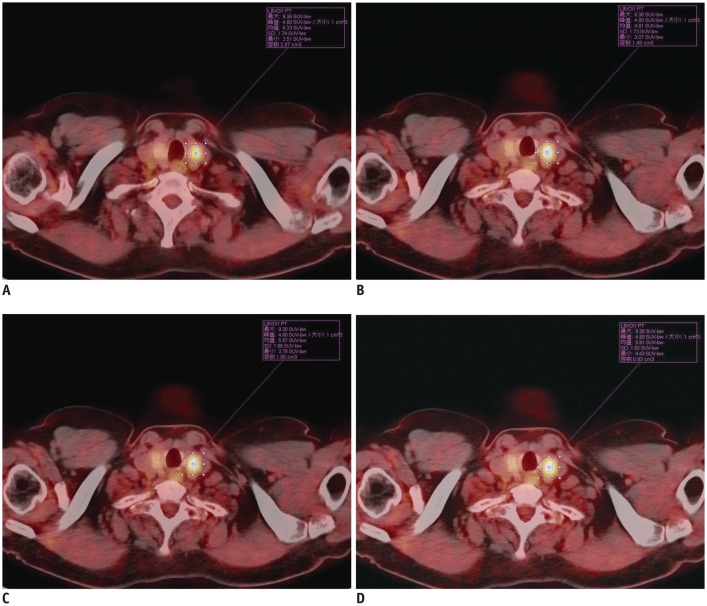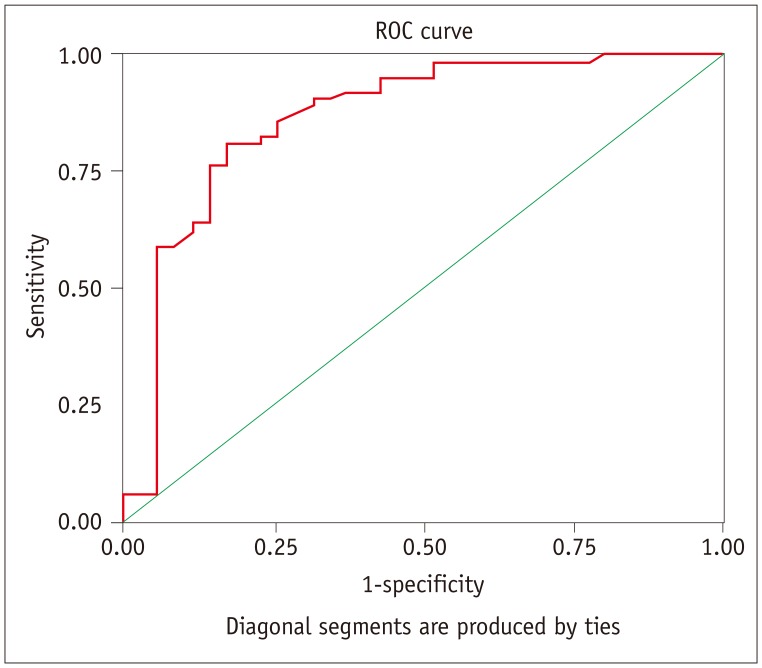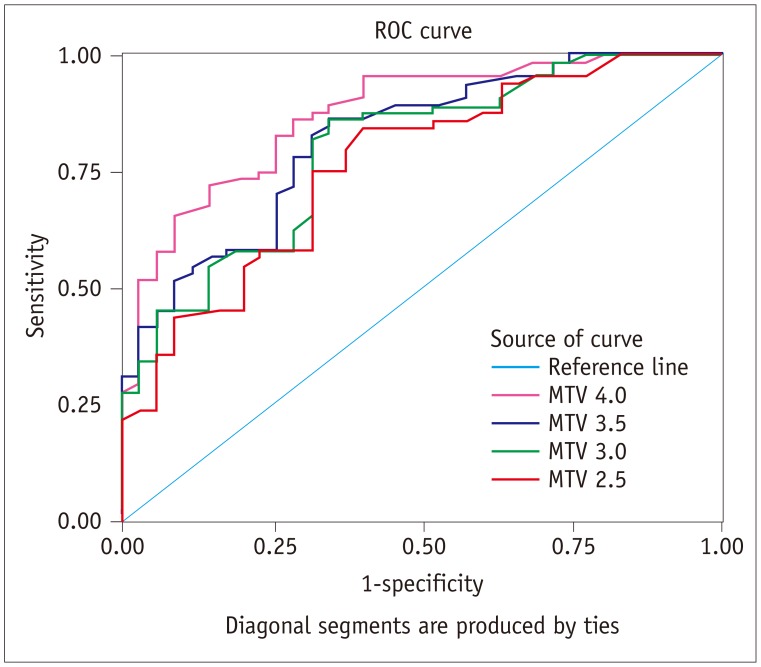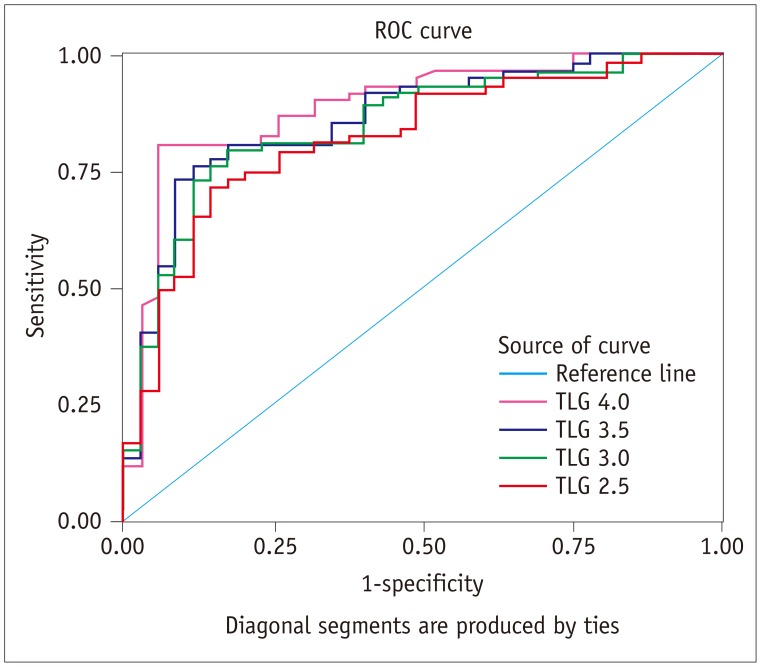Korean J Radiol.
2018 Apr;19(2):342-351. 10.3348/kjr.2018.19.2.342.
Diagnostic Value of Volume-Based Fluorine-18-Fluorodeoxyglucose PET/CT Parameters for Characterizing Thyroid Incidentaloma
- Affiliations
-
- 1Shanghai Universal Medical Imaging Diagnostic Center, Shanghai 200233, China. yuanzheng0404@163.com
- 2Department of Radiology, PET/CT Center, Shanghai 85 Hospital, Shanghai 200052, China.
- 3Department of Radiology, affiliated Changzheng Hospital, The Second Military Medical University, Shanghai 200003, China.
- 4Department of Chemoradiotherapy, Yinzhou People's Hospital, Ningbo 315100, China.
- KMID: 2404932
- DOI: http://doi.org/10.3348/kjr.2018.19.2.342
Abstract
OBJECTIVE
To assess clinical value of fluorine-18-fluorodeoxyglucose positron emission tomography/computed tomography (PET/CT) for differentiation of malignant from benign focal thyroid incidentaloma.
MATERIALS AND METHODS
This retrospective study included 99 patients with focal thyroid incidentaloma of 5216 non-thyroid cancer patients that had undergone PET/CT. PET/CT semi-quantitative parameters, volume-based functional parameters, metabolic tumor volume (MTV), and total lesion glycolysis (TLG) of thyroid incidentaloma were assessed. Receiver-operating characteristic (ROC) analysis was conducted and areas under the curve (AUC) were compared by Hanley and McNeil test to evaluate usefulness of maximum standardized uptake value (SUVmax), MTV and TLG, as markers for differentiating malignant from benign thyroid incidentalomas.
RESULTS
Of 99 thyroid incidentalomas, 64 (64.6%) were malignant and 35 (35.4%) were benign. Malignant thyroid incidentalomas were larger (1.8 cm vs. 1.3 cm, p = 0.006), and had higher SUVmax (11.3 vs. 4.8, p < 0.001), MTV (all p < 0.001) and TLG (all p < 0.001) than benign. TLG 4.0 had the highest performance for differentiation of malignant from benign thyroid incidentaloma in all semi-quantitative parameters with AUC 0.895 by ROC curve analysis. AUC (TLG 4.0) was significantly larger than AUC (SUVmean), AUC (MTV 2.5), AUC (MTV 3.0), AUC (MTV 3.5), AUC (TLG 2.5), and AUC (TLG 3.0), respectively (all, p < 0.05). There was no statistical difference between AUC (TLG 4.0) and AUC (SUVmax) (p > 0.05). A threshold TLG 4.0 of 2.475 had 81.3% sensitivity and 94.3% specificity for identifying malignant thyroid incidentalomas.
CONCLUSION
Volume-based PET/CT parameters could potentially have clinical value in differential diagnosis of thyroid incidentaloma along with SUVmax.
Keyword
MeSH Terms
Figure
Cited by 1 articles
-
Re: Diagnostic Value of Volume-Based Fluorine-18-Fluorodeoxyglucose PET/CT Parameters for Characterizing Thyroid Incidentaloma
Jinshan Zhang, Hongxia Yao, Yuwei Zhang, Haicui Su
Korean J Radiol. 2019;20(6):997-998. doi: 10.3348/kjr.2019.0102.
Reference
-
1. Burguera B, Gharib H. Thyroid incidentalomas. Prevalence, diagnosis, significance, and management. Endocrinol Metab Clin North Am. 2000; 29:187–203. PMID: 10732271.2. Poeppel TD, Krause BJ, Heusner TA, Boy C, Bockisch A, Antoch G. PET/CT for the staging and follow-up of patients with malignancies. Eur J Radiol. 2009; 70:382–392. PMID: 19406595.
Article3. Bomanji JB, Costa DC, Ell PJ. Clinical role of positron emission tomography in oncology. Lancet Oncol. 2001; 2:157–164. PMID: 11902566.
Article4. Chen YK, Ding HJ, Chen KT, Chen YL, Liao AC, Shen YY, et al. Prevalence and risk of cancer of focal thyroid incidentaloma identified by 18F-fluorodeoxyglucose positron emission tomography for cancer screening in healthy subjects. Anticancer Res. 2005; 25:1421–1426. PMID: 15865100.5. Pagano L, Samà MT, Morani F, Prodam F, Rudoni M, Boldorini R, et al. Thyroid incidentaloma identified by 18F-fluorodeoxyglucose positron emission tomography with CT (FDG-PET/CT): clinical and pathological relevance. Clin Endocrinol (Oxf). 2011; 75:528–534. PMID: 21575027.6. Karantanis D, Bogsrud TV, Wiseman GA, Mullan BP, Subramaniam RM, Nathan MA, et al. Clinical significance of diffusely increased 18F-FDG uptake in the thyroid gland. J Nucl Med. 2007; 48:896–901. PMID: 17504869.
Article7. Liu Y. Clinical significance of thyroid uptake on F18-fluorodeoxyglucose positron emission tomography. Ann Nucl Med. 2009; 23:17–23. PMID: 19205834.
Article8. Are C, Hsu JF, Schoder H, Shah JP, Larson SM, Shaha AR. FDG-PET detected thyroid incidentalomas: need for further investigation? Ann Surg Oncol. 2007; 14:239–247. PMID: 17024553.
Article9. Kim TY, Kim WB, Ryu JS, Gong G, Hong SJ, Shong YK. 18F-fluorodeoxyglucose uptake in thyroid from positron emission tomogram (PET) for evaluation in cancer patients: high prevalence of malignancy in thyroid PET incidentaloma. Laryngoscope. 2005; 115:1074–1078. PMID: 15933524.
Article10. Kim BH, Na MA, Kim IJ, Kim SJ, Kim YK. Risk stratification and prediction of cancer of focal thyroid fluorodeoxyglucose uptake during cancer evaluation. Ann Nucl Med. 2010; 24:721–728. PMID: 20830537.
Article11. Kang KW, Kim SK, Kang HS, Lee ES, Sim JS, Lee IG, et al. Prevalence and risk of cancer of focal thyroid incidentaloma identified by 18F-fluorodeoxyglucose positron emission tomography for metastasis evaluation and cancer screening in healthy subjects. J Clin Endocrinol Metab. 2003; 88:4100–4104. PMID: 12970270.12. Bogsrud TV, Karantanis D, Nathan MA, Mullan BP, Wiseman GA, Collins DA, et al. The value of quantifying 18F-FDG uptake in thyroid nodules found incidentally on whole-body PET-CT. Nucl Med Commun. 2007; 28:373–381. PMID: 17414887.
Article13. Dibble EH, Alvarez AC, Truong MT, Mercier G, Cook EF, Subramaniam RM. 18F-FDG metabolic tumor volume and total glycolytic activity of oral cavity and oropharyngeal squamous cell cancer: adding value to clinical staging. J Nucl Med. 2012; 53:709–715. PMID: 22492732.
Article14. I HS, Kim SJ, Kim IJ, Kim K. Predictive value of metabolic tumor volume measured by 18F-FDG PET for regional lymph node status in patients with esophageal cancer. Clin Nucl Med. 2012; 37:442–446. PMID: 22475892.
Article15. Kim BH, Kim SJ, Kim H, Jeon YK, Kim SS, Kim IJ, et al. Diagnostic value of metabolic tumor volume assessed by 18F-FDG PET/CT added to SUVmax for characterization of thyroid 18F-FDG incidentaloma. Nucl Med Commun. 2013; 34:868–876. PMID: 23797273.
Article16. Kim SJ, Chang S. Predictive value of intratumoral heterogeneity of F-18 FDG uptake for characterization of thyroid nodules according to Bethesda categories of fine needle aspiration biopsy results. Endocrine. 2015; 50:681–688. PMID: 25948075.
Article17. Nam SY, Roh JL, Kim JS, Lee JH, Choi SH, Kim SY. Focal uptake of (18)F-fluorodeoxyglucose by thyroid in patients with nonthyroidal head and neck cancers. Clin Endocrinol (Oxf). 2007; 67:135–139. PMID: 17465995.18. Cohen MS, Arslan N, Dehdashti F, Doherty GM, Lairmore TC, Brunt LM, et al. Risk of malignancy in thyroid incidentalomas identified by fluorodeoxyglucose-positron emission tomography. Surgery. 2001; 130:941–946. PMID: 11742321.
Article19. Makis W, Ciarallo A. Thyroid incidentalomas on 18F-FDG PET/CT: clinical significance and controversies. Mol Imaging Radionucl Ther. 2017; 26:93–100. PMID: 28976331.
Article20. Choi JY, Lee KS, Kim HJ, Shim YM, Kwon OJ, Park K, et al. Focal thyroid lesions incidentally identified by integrated 18F-FDG PET/CT: clinical significance and improved characterization. J Nucl Med. 2006; 47:609–615. PMID: 16595494.21. Ho TY, Liou MJ, Lin KJ, Yen TC. Prevalence and significance of thyroid uptake detected by 18F-FDG PET. Endocrine. 2011; 40:297–302. PMID: 21505891.22. Bertagna F, Treglia G, Piccardo A, Giubbini R. Diagnostic and clinical significance of F-18-FDG-PET/CT thyroid incidentalomas. J Clin Endocrinol Metab. 2012; 97:3866–3875. PMID: 22904176.
Article23. Kim H, Kim SJ, Kim IJ, Kim K. Thyroid incidentalomas on FDG PET/CT in patients with non-thyroid cancer - a large retrospective monocentric study. Onkologie. 2013; 36:260–264. PMID: 23689220.
Article24. Erdi YE, Macapinlac H, Rosenzweig KE, Humm JL, Larson SM, Erdi AK, et al. Use of PET to monitor the response of lung cancer to radiation treatment. Eur J Nucl Med. 2000; 27:861–866. PMID: 10952499.
Article25. Van de Wiele C, Kruse V, Smeets P, Sathekge M, Maes A. Predictive and prognostic value of metabolic tumour volume and total lesion glycolysis in solid tumours. Eur J Nucl Med Mol Imaging. 2013; 40:290–301. PMID: 23151913.
Article26. Salvatori M, Melis L, Castaldi P, Maussier ML, Rufini V, Perotti G, et al. Clinical significance of focal and diffuse thyroid diseases identified by (18)F-fluorodeoxyglucose positron emission tomography. Biomed Pharmacother. 2007; 61:488–493. PMID: 17604940.
Article27. Kim D, Hwang SH, Cha J, Jo K, Lee N, Yun M. Risk stratification of thyroid incidentalomas found on PET/CT: the value of iodine content on noncontrast computed tomography. Thyroid. 2015; 25:1249–1254. PMID: 26335604.
Article28. Lee S, Park T, Park S, Pahk K, Rhee S, Cho J, et al. The clinical role of dual-time-point (18)F-FDG PET/CT in differential diagnosis of the thyroid incidentaloma. Nucl Med Mol Imaging. 2014; 48:121–129. PMID: 24900152.
Article29. Barrio M, Czernin J, Yeh MW, Palma Diaz MF, Gupta P, Allen-Auerbach M, et al. The incidence of thyroid cancer in focal hypermetabolic thyroid lesions: an 18F-FDG PET/CT study in more than 6000 patients. Nucl Med Commun. 2016; 37:1290–1296. PMID: 27612034.
- Full Text Links
- Actions
-
Cited
- CITED
-
- Close
- Share
- Similar articles
-
- Re: Diagnostic Value of Volume-Based Fluorine-18-Fluorodeoxyglucose PET/CT Parameters for Characterizing Thyroid Incidentaloma
- 18F-FDG PET/CT and Sonographic Findings of Thyroid Incidentalomas
- Clinical Meaning of Incidental Thyroid Uptake on F-18 FDG PET-CT
- Multifocal Head and Neck Paraganglioma Evaluated with Different PET Tracers: Comparison Between Fluorine-18-Fluorodeoxyglucose and Gallium-68-Somatostatin Receptor PET/CT
- A Case of F-18 FDG PET-CT Detection of Sporadic Medullary Thyroid Carcinoma and Cervical Lymph Node Metastasis of Ovarican Cancer





